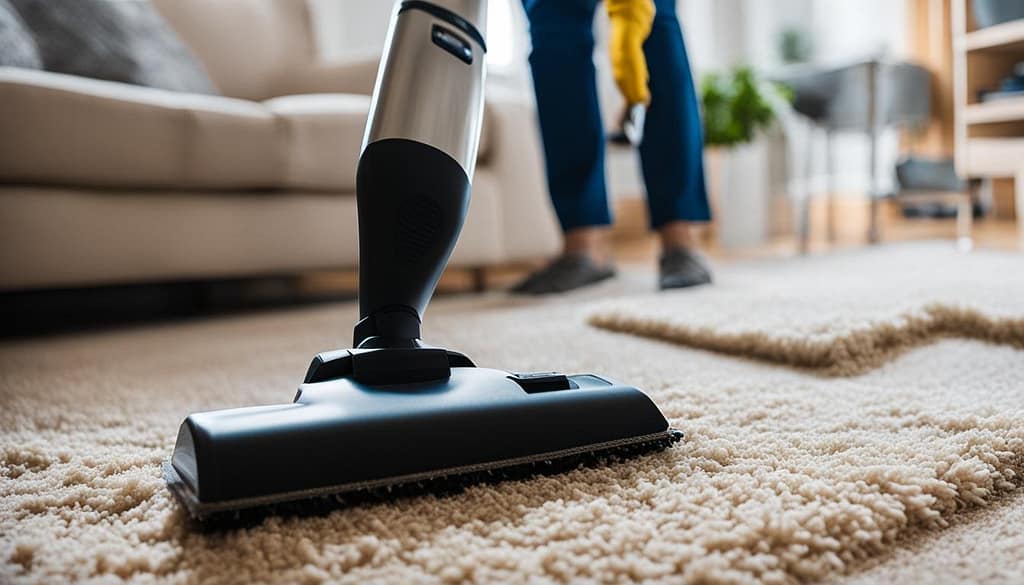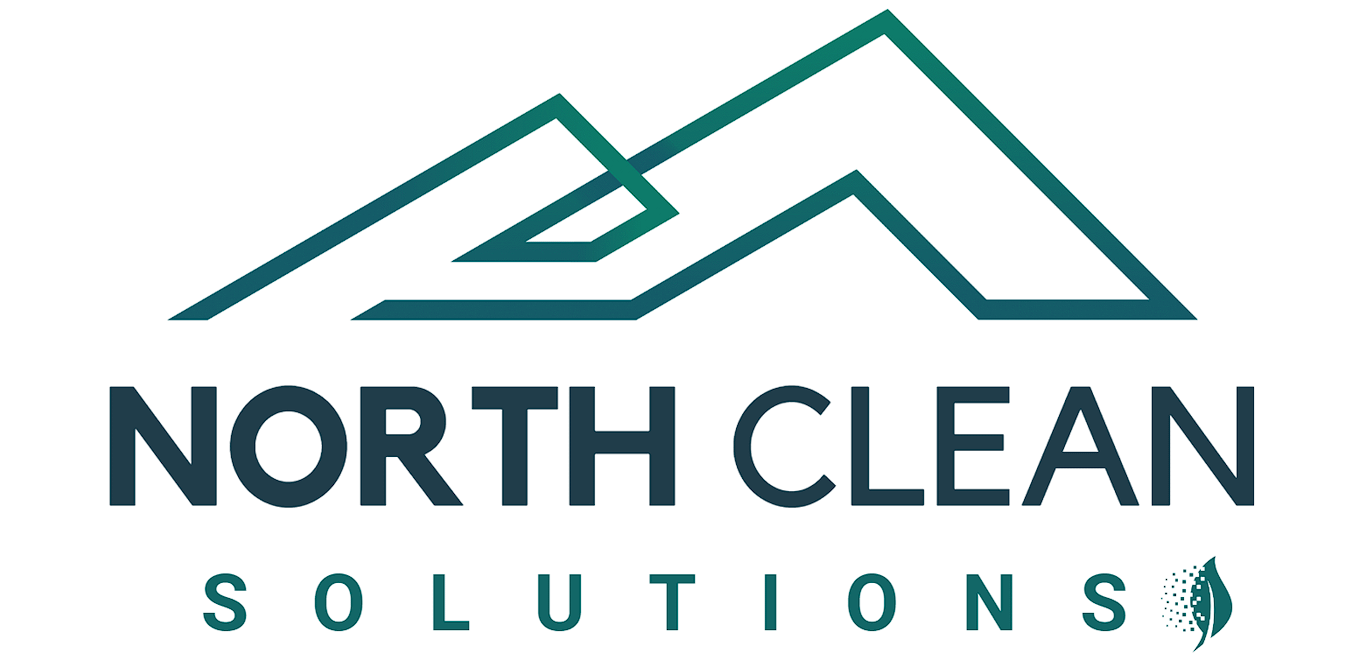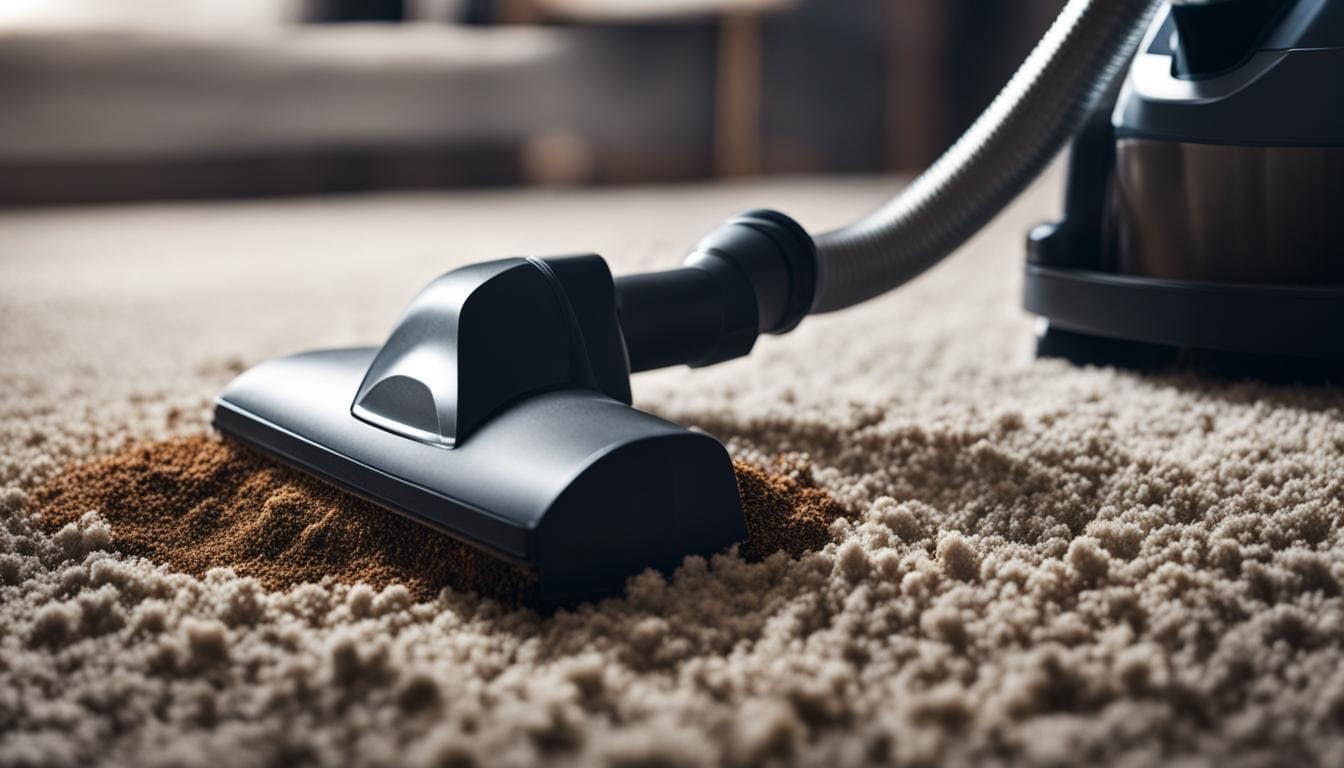In today’s eco-conscious world, finding effective and environmentally friendly cleaning methods is a top priority. When it comes to maintaining clean and fresh carpets, dry carpet cleaning provides a fantastic solution without the need for water. This method not only ensures a thorough cleaning but also offers a range of benefits for your carpets and the environment. In this article, I will guide you through the ins and outs of dry carpet cleaning, exploring various techniques and providing you with a step-by-step guide on how to clean your carpets without water.
Table of Contents
Reasons for Cleaning Carpets Without Water
There are several reasons why one might choose to clean carpets without water. Firstly, delicate materials such as silk fibers, sisal, and jute require special care and should be sanitized without water. These materials are sensitive to moisture and can be easily damaged by traditional washing methods. By opting for dry cleaning techniques, homeowners can ensure the longevity and pristine condition of their delicate carpets.
Secondly, dry cleaning helps prevent the development of mold and mildew, which can pose health risks to individuals living in the space. Moisture from water-based cleaning methods can create a breeding ground for these harmful organisms, leading to unpleasant odor, allergies, and respiratory problems. By eliminating the use of water, dry cleaning methods eliminate the risk of mold and mildew growth, creating a healthier indoor environment.
Finally, dry cleaning offers a more time and energy-efficient approach compared to traditional washing methods. With waterless carpet cleaning, there is no need to wait for the carpet to dry after cleaning, significantly reducing the cleaning process’s overall duration. Additionally, the absence of water eliminates the need for excessive rinsing, extracting, and drying processes, saving both time and energy.
“Dry cleaning techniques are essential for maintaining delicate materials, preventing mold and mildew growth, and saving time and energy.”
To illustrate the differences between dry carpet cleaning and traditional water-based methods, refer to the following table:
| Dry Carpet Cleaning | Traditional Water-based Cleaning |
|---|---|
| Gentle on delicate materials | Potential damage to delicate materials |
| Prevents mold and mildew growth | Risk of mold and mildew development |
| Quick drying time, no waiting period | Lengthy drying time required |
| Minimal water usage | High water consumption |
| Eco-friendly and non-toxic | Potential exposure to chemical residues |
Methods of Dry Carpet Cleaning
Dry carpet cleaning offers a variety of effective methods for sanitizing carpets without using water. These methods include:
| Method | Description |
|---|---|
| Upholstery Cleaning | Utilizes air-powered turbo vacuums to remove dust and grime from the carpet fibers. |
| Vacuuming the Carpet | Involves regular vacuuming of all areas of the carpet, focusing on high-traffic areas and emptying the vacuum bag after each use. |
| Steam Cleaning | Uses steam to penetrate deep into the carpet fibers and extract dirt, stains, and odors. |
| Bonnet Sanitizing | Uses a specialized rotary machine with a bonnet pad soaked in a cleaning solution to agitate and absorb dirt from the carpet’s surface. |
| Deodorize with Vinegar | Eliminates odors by mixing equal parts vinegar and water in a spray bottle and misting it lightly onto the carpet. |
| Baking Soda | Acts as a natural deodorizer and stain remover by sprinkling it on the carpet, allowing it to sit for a few hours, and then vacuuming it up. |
| Using Shampoos | Applies carpet shampoo with a brush or a machine, which breaks down dirt and stains, and then extracts the shampoo and dirt using a vacuum or professional-grade carpet cleaner. |
These techniques effectively clean carpets without the use of water, providing a convenient and efficient solution for maintaining a fresh and sanitized carpet.

Benefits of Dry Carpet Cleaning
Dry carpet cleaning offers several key benefits that make it an attractive option for homeowners. This method not only provides effective cleaning, but it also prioritizes eco-friendly practices and eliminates the need for harsh chemicals. Let’s explore the advantages of dry carpet cleaning:
Eco-Friendly Carpet Cleaning
Dry carpet cleaning is an eco-friendly alternative that minimizes water usage and reduces environmental impact. Traditional carpet cleaning methods often require large amounts of water, contributing to water waste and potential damage to the environment. By opting for dry carpet cleaning, you can help conserve water resources while still maintaining a spotless and fresh carpet.
Chemical-Free Cleaning
One of the significant advantages of dry carpet cleaning is that it is chemical-free. Unlike traditional methods that rely on harsh cleaning agents, dry cleaning utilizes innovative techniques that eliminate the need for chemical-based solutions. This makes dry carpet cleaning a safe option for both humans and pets, ensuring a healthy living environment in your home.
Rapid Drying Time
When you choose dry carpet cleaning, you don’t have to wait hours or even days for your carpets to dry completely. With this method, the cleaning process involves minimal moisture, allowing your carpets to dry quickly. This is especially beneficial for busy households or commercial spaces where minimal downtime is desired. You can enjoy revitalized carpets without the hassle of a prolonged drying period.
Prevents Carpet Damage
Water-based cleaning methods can sometimes lead to carpet damage, such as stretching, shrinking, or discoloration. Dry carpet cleaning eliminates the risks associated with excess moisture, protecting your carpets from potential harm. By opting for dry cleaning, you can ensure the longevity and quality of your carpets, extending their lifespan.
Maintains Carpet Appearance
The use of dry cleaning techniques helps to maintain the appearance of your carpets. Dust, allergens, and dirt can accumulate in the fibers over time, leading to a dull and worn-out look. Dry carpet cleaning effectively removes these particles, restoring the vibrancy and freshness of your carpets. Regular dry cleaning sessions can help maintain the aesthetic appeal of your carpets, keeping them looking new for longer.

In addition to these benefits, dry carpet cleaning also offers convenience and efficiency. It is a time-saving method that allows for quick and effective cleaning without the need for extensive drying time. By choosing dry cleaning, you can achieve a clean and healthy carpet while minimizing the impact on the environment.
How to Clean a Carpet Without Water – Step-by-Step Guide
Cleaning a carpet without water is a simple process that can effectively remove dirt and stains from your carpet. Here is a step-by-step guide to help you through the process:
- Vacuum the carpet: Start by thoroughly vacuuming the entire carpet surface to remove loose dirt, dust, and debris. Use a vacuum cleaner with a powerful suction and be sure to go over each area multiple times to ensure a thorough clean.
- Apply dry powder: Next, apply a dry carpet cleaning powder onto the carpet surface. This powder is designed to absorb dirt and stains without the need for water. Sprinkle the powder evenly over the carpet and use a soft brush or broom to work it into the fibers.
- Vacuum away the powder: Allow the dry powder to sit on the carpet for the recommended time specified on the product’s instructions. This allows the powder to penetrate and absorb any dirt or stains. Once the time has elapsed, use a vacuum cleaner to thoroughly remove the powder from the carpet. Be sure to go over each area multiple times to ensure all the powder is extracted.
- Spot cleaning: If you have any stubborn stains on your carpet, you can use specific dry carpet cleaning products or homemade solutions to target and remove them. Follow the instructions provided on the product or prepare the homemade solution as recommended.
- Allow for thorough drying: After cleaning the carpet, it is essential to allow it to dry completely before walking on it or placing any furniture back onto it. Open windows and doors to promote airflow and use fans or dehumidifiers to speed up the drying process.
By following these steps, you can effectively clean your carpet without the need for water, ensuring a fresh and sanitized result. Remember to always refer to the instructions provided by the cleaning product manufacturer and test any homemade solutions on a small, inconspicuous area of the carpet before applying them to the entire surface.

“Dry carpet cleaning provides an efficient and waterless solution for maintaining a clean and fresh carpet.”
Tips for Maintaining a Clean Carpet Without Water
To keep your carpet clean and fresh without the use of water, there are several essential tips to follow. By implementing these practices, you can ensure the longevity and cleanliness of your carpets, while avoiding the risks associated with excessive water usage.
1. Place Doormats at All Entrances
Reducing the amount of dirt and debris that enters your home is crucial for maintaining a clean carpet. Placing doormats at all entrances can effectively trap dirt, preventing it from being tracked onto your carpets. It is recommended to use high-quality doormats that are durable and easy to clean, ensuring maximum effectiveness in keeping your carpets dirt-free.
2. Remove Shoes Before Walking on the Carpet
As shoes can bring in dirt, germs, and other contaminants from the outside, it’s a good practice to remove shoes before stepping onto your carpets. Encourage family members and guests to take off their shoes at the entrance to minimize the transfer of dirt and stains onto your carpets.
3. Promptly Clean Spills and Stains
Accidents happen, and when spills occur, it’s crucial to act quickly to prevent the stain from setting in. Use a clean cloth or paper towel to blot the spill gently, removing as much liquid as possible. Avoid rubbing or scrubbing, as this can spread the stain and damage the carpet fibers. Depending on the type of stain, you can then apply an appropriate carpet stain removal solution or consult a professional cleaner for tough stains.
4. Regular Vacuuming
Vacuuming is a fundamental step in maintaining a clean carpet without water. Regular vacuuming helps remove surface dirt, dust, and allergens, preventing them from settling deep into the carpet fibers. It is recommended to vacuum at least once a week, focusing on high-traffic areas and using attachments to reach corners and edges.
5. Deep Cleaning Every 3-6 Months
While regular vacuuming is essential, deep cleaning should also be done periodically to remove embedded dirt and refresh the carpet. There are various dry carpet cleaning methods available, such as using dry carpet cleaner powders or employing professional carpet cleaning services that specialize in waterless techniques. Deep cleaning every 3-6 months will help maintain the appearance and hygiene of your carpets.
Implementing these tips will help you maintain a clean carpet without the use of water, ensuring that your carpets remain fresh, hygienic, and long-lasting.
Conclusion
Dry carpet cleaning is an excellent choice for homeowners looking for an effective and eco-friendly solution to sanitize their carpets without water. With various methods available, such as upholstery cleaning, vacuuming, steam cleaning, bonnet sanitizing, deodorizing with vinegar, using baking soda, and carpet shampooing, you can easily find the perfect technique to suit your needs.
By following the step-by-step guide mentioned earlier and implementing the provided tips, you can maintain a fresh and sanitized carpet while minimizing water usage and reducing your environmental impact. Dry carpet cleaning not only saves you time and energy but also ensures the longevity of your carpet by preventing mold and mildew growth.
Investing in dry carpet cleaning methods allows you to enjoy an eco-friendly carpet cleaning experience without the need for harmful chemicals. Say goodbye to wet carpets and hello to a quick-drying, clean carpet that looks and feels great. So, embrace the benefits of dry carpet cleaning and transform your home into a clean and healthy environment for you and your loved ones.
FAQ
How does dry carpet cleaning work?
Dry carpet cleaning involves using methods such as vacuuming, steam cleaning, bonnet sanitizing, and deodorizing with vinegar or baking soda to clean carpets without water.
Is dry carpet cleaning suitable for delicate materials?
Yes, dry carpet cleaning is perfect for delicate materials like silk fibers, sisal, and jute as it avoids the risk of damage caused by water.
Can dry carpet cleaning prevent mold and mildew growth?
Yes, dry carpet cleaning helps prevent the development of mold and mildew, reducing the risk of health hazards.
What are the benefits of dry carpet cleaning?
Dry carpet cleaning is eco-friendly, chemical-free, saves time, prevents carpet damage, and helps maintain the appearance of the carpet.
How can I clean a carpet without water?
To clean a carpet without water, you can use methods like vacuuming, steam cleaning, brushing, using baking soda or vinegar, and spot cleaning for stubborn stains.
How often should I deep clean my carpet without water?
It is recommended to deep clean your carpet without water every 3-6 months to maintain its cleanliness and sanitation.
What can I do to maintain a clean carpet without water?
To maintain a clean carpet without water, you can place doormats at entrances, remove shoes before walking on the carpet, promptly clean spills, and regularly vacuum and deep clean using dry methods.


